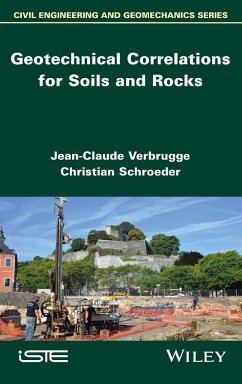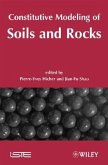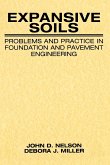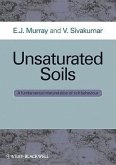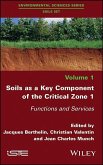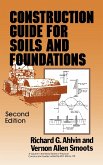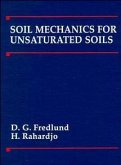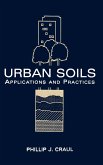- Gebundenes Buch
- Merkliste
- Auf die Merkliste
- Bewerten Bewerten
- Teilen
- Produkt teilen
- Produkterinnerung
- Produkterinnerung
The modelling tools for soils and rocks require more and more specific parameters not always available from the standard or usual survey campaigns, this generally for reasons of delay or costs. The use of correlations to solve the gap between available parameters and the required ones is a common practice. Many of them exist but are spread throughout numerous papers or books. The aim of this formulary is to provide a large synthesis of the existing correlations accumulated by the authors during more than 40 years academic and consulting careers.
Andere Kunden interessierten sich auch für
![Constitutive Modeling of Soils and Rocks Constitutive Modeling of Soils and Rocks]() Constitutive Modeling of Soils and Rocks332,99 €
Constitutive Modeling of Soils and Rocks332,99 €![Expansive Soils Expansive Soils]() John NelsonExpansive Soils176,99 €
John NelsonExpansive Soils176,99 €![Unsaturated Soils Unsaturated Soils]() E J MurrayUnsaturated Soils141,99 €
E J MurrayUnsaturated Soils141,99 €![Soils as a Key Component of the Critical Zone 1 Soils as a Key Component of the Critical Zone 1]() Soils as a Key Component of the Critical Zone 1186,99 €
Soils as a Key Component of the Critical Zone 1186,99 €![Construction Guide for Soils and Foundations Construction Guide for Soils and Foundations]() Richard G AhlvinConstruction Guide for Soils and Foundations212,99 €
Richard G AhlvinConstruction Guide for Soils and Foundations212,99 €![Soil Mechanics for Unsaturated Soils Soil Mechanics for Unsaturated Soils]() Delwyn G FredlundSoil Mechanics for Unsaturated Soils221,99 €
Delwyn G FredlundSoil Mechanics for Unsaturated Soils221,99 €![Urban Soils Urban Soils]() Phillip J CraulUrban Soils190,99 €
Phillip J CraulUrban Soils190,99 €-
-
-
The modelling tools for soils and rocks require more and more specific parameters not always available from the standard or usual survey campaigns, this generally for reasons of delay or costs. The use of correlations to solve the gap between available parameters and the required ones is a common practice. Many of them exist but are spread throughout numerous papers or books. The aim of this formulary is to provide a large synthesis of the existing correlations accumulated by the authors during more than 40 years academic and consulting careers.
Hinweis: Dieser Artikel kann nur an eine deutsche Lieferadresse ausgeliefert werden.
Hinweis: Dieser Artikel kann nur an eine deutsche Lieferadresse ausgeliefert werden.
Produktdetails
- Produktdetails
- Verlag: Wiley
- Seitenzahl: 232
- Erscheinungstermin: 31. Juli 2018
- Englisch
- Abmessung: 240mm x 161mm x 17mm
- Gewicht: 522g
- ISBN-13: 9781786302793
- ISBN-10: 1786302799
- Artikelnr.: 53066383
- Herstellerkennzeichnung
- Libri GmbH
- Europaallee 1
- 36244 Bad Hersfeld
- gpsr@libri.de
- Verlag: Wiley
- Seitenzahl: 232
- Erscheinungstermin: 31. Juli 2018
- Englisch
- Abmessung: 240mm x 161mm x 17mm
- Gewicht: 522g
- ISBN-13: 9781786302793
- ISBN-10: 1786302799
- Artikelnr.: 53066383
- Herstellerkennzeichnung
- Libri GmbH
- Europaallee 1
- 36244 Bad Hersfeld
- gpsr@libri.de
Jean-Claude Verbrugge, Université libre de Bruxelles and University of Liège, Belgium. Christian Schroeder, Université libre de Bruxelles and University of Liège, Belgium.
Acknowledgements xi
Preface xiii
Chapter 1. Physical Parameters 1
1.1. Unit weights and volumes 1
1.2. Soil behavior type index and soil classification index 3
1.3. Consistency or Atterberg limits 3
1.4. Consistency and liquidity indices 4
1.5. Rigidity index 5
1.6. Relative density of sands 5
1.7. Wave velocity 7
1.8. Cation exchange capacity 8
Chapter 2. Identification of Soil Types 11
2.1. From identification tests 11
2.2. From cone soil index ¿ IC 12
2.3. From CPT 12
2.4. From PMT 15
2.5. From SPT 17
2.6. From DMT 18
Chapter 3. Hydraulic Parameters 21
3.1. Hydraulic conductivity 21
3.2. Water storage capacity 23
3.2.1. For a free water table 23
3.2.2. For a confined aquifer 24
Chapter 4. Strength Parameters of Saturated and Dry Soils 25
4.1. Undrained shear strength and cohesion 25
4.1.1. From identification tests 25
4.1.2. From laboratory tests 26
4.1.3. From CPT 27
4.1.4. From PMT 28
4.1.5. From SPT 29
4.1.6. From SCPT 29
4.1.7. From DMT 30
4.1.8. From VST 30
4.1.9. Overconsolidated soils 31
4.1.10. Miscellaneous: peats and remolded soils 32
4.2. Effective cohesion 33
4.3. Internal friction angle 33
4.3.1. From identification tests 33
4.3.2. From CPT and CPTu 35
4.3.3. From SCPT 36
4.3.4. From PMT 36
4.3.5. From SPT 37
4.3.6. From DMT 38
4.3.7. Peak, critical state and residual friction angles 39
4.3.8. Influence of intermediate stress 40
4.4. The angle of dilatancy 41
4.5. Sensitivity 42
Chapter 5. Soil Deformations 43
5.1. Compression and swelling 43
5.1.1. Compression index 43
5.1.2. Constants of compressibility 47
5.1.3. Swelling index 48
5.2. Soil moduli 48
5.2.1. From CPT 49
5.2.2. From DMT 51
5.2.3. From SPT 52
5.2.4. From CBR 53
5.2.5. Influence of loading rate 54
5.3. Small strain modulus 54
5.4. Poisson's ratio 58
5.5. Modulus of subgrade reaction 59
5.6. Resilient modulus 60
5.7. Collapse and expansion 60
Chapter 6. Soil State Parameters 63
6.1. Preconsolidation pressure 63
6.2. Overconsolidation ratio 66
Chapter 7. Consolidation 69
7.1. Primary consolidation coefficient 69
7.2. Secondary consolidation coefficient 70
7.3. Consolidation of peats 71
7.4. Degree of consolidation 72
Chapter 8. Coefficient of Earth Pressure at Rest 73
Chapter 9. Soil Compaction Tests 77
9.1. Proctor tests 77
9.1.1. Standard Proctor test 77
9.1.2. Modified Proctor test 78
9.2. CBR 79
Chapter 10. Unsaturated Soils 81
10.1. Suction 81
10.2. Bishop's coefficient 83
10.3. Quasi-saturated domain 84
10.4. tress dependency of suction 84
10.5. Drying path of quasi-saturated soils 85
10.6. Capillary or apparent cohesion 86
10.7. Estimation of porosity and degree of saturation from compression wave
velocity 87
Chapter 11. Cross Relations between In Situ Test Parameters 89
11.1. CPT 89
11.1.1. Correction factors and correlations between different CPT tests or
parameters 89
11.1.2. CPT and DPT 91
11.1.3. CPT and PMT 92
11.1.4. CPT and DMT 93
11.1.5. CPT and SPT 94
11.2. MT 97
11.2.1. MT and DPT 97
11.2.2. MT and DMT 98
11.2.3. MT and SPT 98
11.3. DMT 99
11.3.1. DMT and SPT 99
11.4. SPT 100
11.4.1. SPT and DPT 100
11.5. PANDA dynamic penetration test 100
11.5.1. PANDA and CPT 100
11.5.2. PANDA and DPT 101
11.5.3. PANDA and PMT 101
11.5.4. PANDA and VST 101
Chapter 12. Rocks 103
12.1. Introduction 103
12.2. Fundamental properties of intact minerals 106
12.3. Rock material (rm) 108
12.3.1. UCS 109
12.3.2. Abrasiveness 117
12.3.3. Attrition 119
12.3.4. Polished stone value (PSV) 122
12.4. Rock masses (RMs) 124
12.4.1. Shear strength of discontinuities 124
12.4.2. RM classification systems 126
Chapter 13. Usual Values of Soils and Rock Parameters 141
13.1. Physical parameters 141
13.1.1. Plasticity, unit weights and porosity 141
13.1.2. Consistency and related strength parameters 142
13.1.3. Soil indices 142
13.1.4. Soil and rock resistivity 143
13.1.5. Wave velocity 143
13.1.6. Clay minerals and CEC 144
13.2. Hydraulic parameters 144
13.2.1. Hydraulic conductivity 144
13.2.2. Water storage capacity 145
13.3. Strength parameters 145
13.4. Deformation parameters 145
13.4.1. Compression index 145
13.4.2. Soil modulus 146
13.4.3. Poisson's ratio 146
13.4.4. mall strain modulus 147
13.5. Consolidation parameters 147
13.5.1. Primary consolidation 147
13.6. In situ test parameters 148
13.6.1. CPT 148
13.6.2. MT 148
13.6.3. DMT 149
13.6.4. SPT 149
13.7. Rock parameters 149
13.7.1. Rock materials 150
13.7.2. Rock masses 153
List of Symbols 159
List of Equations 169
List of Abbreviations and Acronyms 173
Bibliography 177
Index 205
Preface xiii
Chapter 1. Physical Parameters 1
1.1. Unit weights and volumes 1
1.2. Soil behavior type index and soil classification index 3
1.3. Consistency or Atterberg limits 3
1.4. Consistency and liquidity indices 4
1.5. Rigidity index 5
1.6. Relative density of sands 5
1.7. Wave velocity 7
1.8. Cation exchange capacity 8
Chapter 2. Identification of Soil Types 11
2.1. From identification tests 11
2.2. From cone soil index ¿ IC 12
2.3. From CPT 12
2.4. From PMT 15
2.5. From SPT 17
2.6. From DMT 18
Chapter 3. Hydraulic Parameters 21
3.1. Hydraulic conductivity 21
3.2. Water storage capacity 23
3.2.1. For a free water table 23
3.2.2. For a confined aquifer 24
Chapter 4. Strength Parameters of Saturated and Dry Soils 25
4.1. Undrained shear strength and cohesion 25
4.1.1. From identification tests 25
4.1.2. From laboratory tests 26
4.1.3. From CPT 27
4.1.4. From PMT 28
4.1.5. From SPT 29
4.1.6. From SCPT 29
4.1.7. From DMT 30
4.1.8. From VST 30
4.1.9. Overconsolidated soils 31
4.1.10. Miscellaneous: peats and remolded soils 32
4.2. Effective cohesion 33
4.3. Internal friction angle 33
4.3.1. From identification tests 33
4.3.2. From CPT and CPTu 35
4.3.3. From SCPT 36
4.3.4. From PMT 36
4.3.5. From SPT 37
4.3.6. From DMT 38
4.3.7. Peak, critical state and residual friction angles 39
4.3.8. Influence of intermediate stress 40
4.4. The angle of dilatancy 41
4.5. Sensitivity 42
Chapter 5. Soil Deformations 43
5.1. Compression and swelling 43
5.1.1. Compression index 43
5.1.2. Constants of compressibility 47
5.1.3. Swelling index 48
5.2. Soil moduli 48
5.2.1. From CPT 49
5.2.2. From DMT 51
5.2.3. From SPT 52
5.2.4. From CBR 53
5.2.5. Influence of loading rate 54
5.3. Small strain modulus 54
5.4. Poisson's ratio 58
5.5. Modulus of subgrade reaction 59
5.6. Resilient modulus 60
5.7. Collapse and expansion 60
Chapter 6. Soil State Parameters 63
6.1. Preconsolidation pressure 63
6.2. Overconsolidation ratio 66
Chapter 7. Consolidation 69
7.1. Primary consolidation coefficient 69
7.2. Secondary consolidation coefficient 70
7.3. Consolidation of peats 71
7.4. Degree of consolidation 72
Chapter 8. Coefficient of Earth Pressure at Rest 73
Chapter 9. Soil Compaction Tests 77
9.1. Proctor tests 77
9.1.1. Standard Proctor test 77
9.1.2. Modified Proctor test 78
9.2. CBR 79
Chapter 10. Unsaturated Soils 81
10.1. Suction 81
10.2. Bishop's coefficient 83
10.3. Quasi-saturated domain 84
10.4. tress dependency of suction 84
10.5. Drying path of quasi-saturated soils 85
10.6. Capillary or apparent cohesion 86
10.7. Estimation of porosity and degree of saturation from compression wave
velocity 87
Chapter 11. Cross Relations between In Situ Test Parameters 89
11.1. CPT 89
11.1.1. Correction factors and correlations between different CPT tests or
parameters 89
11.1.2. CPT and DPT 91
11.1.3. CPT and PMT 92
11.1.4. CPT and DMT 93
11.1.5. CPT and SPT 94
11.2. MT 97
11.2.1. MT and DPT 97
11.2.2. MT and DMT 98
11.2.3. MT and SPT 98
11.3. DMT 99
11.3.1. DMT and SPT 99
11.4. SPT 100
11.4.1. SPT and DPT 100
11.5. PANDA dynamic penetration test 100
11.5.1. PANDA and CPT 100
11.5.2. PANDA and DPT 101
11.5.3. PANDA and PMT 101
11.5.4. PANDA and VST 101
Chapter 12. Rocks 103
12.1. Introduction 103
12.2. Fundamental properties of intact minerals 106
12.3. Rock material (rm) 108
12.3.1. UCS 109
12.3.2. Abrasiveness 117
12.3.3. Attrition 119
12.3.4. Polished stone value (PSV) 122
12.4. Rock masses (RMs) 124
12.4.1. Shear strength of discontinuities 124
12.4.2. RM classification systems 126
Chapter 13. Usual Values of Soils and Rock Parameters 141
13.1. Physical parameters 141
13.1.1. Plasticity, unit weights and porosity 141
13.1.2. Consistency and related strength parameters 142
13.1.3. Soil indices 142
13.1.4. Soil and rock resistivity 143
13.1.5. Wave velocity 143
13.1.6. Clay minerals and CEC 144
13.2. Hydraulic parameters 144
13.2.1. Hydraulic conductivity 144
13.2.2. Water storage capacity 145
13.3. Strength parameters 145
13.4. Deformation parameters 145
13.4.1. Compression index 145
13.4.2. Soil modulus 146
13.4.3. Poisson's ratio 146
13.4.4. mall strain modulus 147
13.5. Consolidation parameters 147
13.5.1. Primary consolidation 147
13.6. In situ test parameters 148
13.6.1. CPT 148
13.6.2. MT 148
13.6.3. DMT 149
13.6.4. SPT 149
13.7. Rock parameters 149
13.7.1. Rock materials 150
13.7.2. Rock masses 153
List of Symbols 159
List of Equations 169
List of Abbreviations and Acronyms 173
Bibliography 177
Index 205
Acknowledgements xi
Preface xiii
Chapter 1. Physical Parameters 1
1.1. Unit weights and volumes 1
1.2. Soil behavior type index and soil classification index 3
1.3. Consistency or Atterberg limits 3
1.4. Consistency and liquidity indices 4
1.5. Rigidity index 5
1.6. Relative density of sands 5
1.7. Wave velocity 7
1.8. Cation exchange capacity 8
Chapter 2. Identification of Soil Types 11
2.1. From identification tests 11
2.2. From cone soil index ¿ IC 12
2.3. From CPT 12
2.4. From PMT 15
2.5. From SPT 17
2.6. From DMT 18
Chapter 3. Hydraulic Parameters 21
3.1. Hydraulic conductivity 21
3.2. Water storage capacity 23
3.2.1. For a free water table 23
3.2.2. For a confined aquifer 24
Chapter 4. Strength Parameters of Saturated and Dry Soils 25
4.1. Undrained shear strength and cohesion 25
4.1.1. From identification tests 25
4.1.2. From laboratory tests 26
4.1.3. From CPT 27
4.1.4. From PMT 28
4.1.5. From SPT 29
4.1.6. From SCPT 29
4.1.7. From DMT 30
4.1.8. From VST 30
4.1.9. Overconsolidated soils 31
4.1.10. Miscellaneous: peats and remolded soils 32
4.2. Effective cohesion 33
4.3. Internal friction angle 33
4.3.1. From identification tests 33
4.3.2. From CPT and CPTu 35
4.3.3. From SCPT 36
4.3.4. From PMT 36
4.3.5. From SPT 37
4.3.6. From DMT 38
4.3.7. Peak, critical state and residual friction angles 39
4.3.8. Influence of intermediate stress 40
4.4. The angle of dilatancy 41
4.5. Sensitivity 42
Chapter 5. Soil Deformations 43
5.1. Compression and swelling 43
5.1.1. Compression index 43
5.1.2. Constants of compressibility 47
5.1.3. Swelling index 48
5.2. Soil moduli 48
5.2.1. From CPT 49
5.2.2. From DMT 51
5.2.3. From SPT 52
5.2.4. From CBR 53
5.2.5. Influence of loading rate 54
5.3. Small strain modulus 54
5.4. Poisson's ratio 58
5.5. Modulus of subgrade reaction 59
5.6. Resilient modulus 60
5.7. Collapse and expansion 60
Chapter 6. Soil State Parameters 63
6.1. Preconsolidation pressure 63
6.2. Overconsolidation ratio 66
Chapter 7. Consolidation 69
7.1. Primary consolidation coefficient 69
7.2. Secondary consolidation coefficient 70
7.3. Consolidation of peats 71
7.4. Degree of consolidation 72
Chapter 8. Coefficient of Earth Pressure at Rest 73
Chapter 9. Soil Compaction Tests 77
9.1. Proctor tests 77
9.1.1. Standard Proctor test 77
9.1.2. Modified Proctor test 78
9.2. CBR 79
Chapter 10. Unsaturated Soils 81
10.1. Suction 81
10.2. Bishop's coefficient 83
10.3. Quasi-saturated domain 84
10.4. tress dependency of suction 84
10.5. Drying path of quasi-saturated soils 85
10.6. Capillary or apparent cohesion 86
10.7. Estimation of porosity and degree of saturation from compression wave
velocity 87
Chapter 11. Cross Relations between In Situ Test Parameters 89
11.1. CPT 89
11.1.1. Correction factors and correlations between different CPT tests or
parameters 89
11.1.2. CPT and DPT 91
11.1.3. CPT and PMT 92
11.1.4. CPT and DMT 93
11.1.5. CPT and SPT 94
11.2. MT 97
11.2.1. MT and DPT 97
11.2.2. MT and DMT 98
11.2.3. MT and SPT 98
11.3. DMT 99
11.3.1. DMT and SPT 99
11.4. SPT 100
11.4.1. SPT and DPT 100
11.5. PANDA dynamic penetration test 100
11.5.1. PANDA and CPT 100
11.5.2. PANDA and DPT 101
11.5.3. PANDA and PMT 101
11.5.4. PANDA and VST 101
Chapter 12. Rocks 103
12.1. Introduction 103
12.2. Fundamental properties of intact minerals 106
12.3. Rock material (rm) 108
12.3.1. UCS 109
12.3.2. Abrasiveness 117
12.3.3. Attrition 119
12.3.4. Polished stone value (PSV) 122
12.4. Rock masses (RMs) 124
12.4.1. Shear strength of discontinuities 124
12.4.2. RM classification systems 126
Chapter 13. Usual Values of Soils and Rock Parameters 141
13.1. Physical parameters 141
13.1.1. Plasticity, unit weights and porosity 141
13.1.2. Consistency and related strength parameters 142
13.1.3. Soil indices 142
13.1.4. Soil and rock resistivity 143
13.1.5. Wave velocity 143
13.1.6. Clay minerals and CEC 144
13.2. Hydraulic parameters 144
13.2.1. Hydraulic conductivity 144
13.2.2. Water storage capacity 145
13.3. Strength parameters 145
13.4. Deformation parameters 145
13.4.1. Compression index 145
13.4.2. Soil modulus 146
13.4.3. Poisson's ratio 146
13.4.4. mall strain modulus 147
13.5. Consolidation parameters 147
13.5.1. Primary consolidation 147
13.6. In situ test parameters 148
13.6.1. CPT 148
13.6.2. MT 148
13.6.3. DMT 149
13.6.4. SPT 149
13.7. Rock parameters 149
13.7.1. Rock materials 150
13.7.2. Rock masses 153
List of Symbols 159
List of Equations 169
List of Abbreviations and Acronyms 173
Bibliography 177
Index 205
Preface xiii
Chapter 1. Physical Parameters 1
1.1. Unit weights and volumes 1
1.2. Soil behavior type index and soil classification index 3
1.3. Consistency or Atterberg limits 3
1.4. Consistency and liquidity indices 4
1.5. Rigidity index 5
1.6. Relative density of sands 5
1.7. Wave velocity 7
1.8. Cation exchange capacity 8
Chapter 2. Identification of Soil Types 11
2.1. From identification tests 11
2.2. From cone soil index ¿ IC 12
2.3. From CPT 12
2.4. From PMT 15
2.5. From SPT 17
2.6. From DMT 18
Chapter 3. Hydraulic Parameters 21
3.1. Hydraulic conductivity 21
3.2. Water storage capacity 23
3.2.1. For a free water table 23
3.2.2. For a confined aquifer 24
Chapter 4. Strength Parameters of Saturated and Dry Soils 25
4.1. Undrained shear strength and cohesion 25
4.1.1. From identification tests 25
4.1.2. From laboratory tests 26
4.1.3. From CPT 27
4.1.4. From PMT 28
4.1.5. From SPT 29
4.1.6. From SCPT 29
4.1.7. From DMT 30
4.1.8. From VST 30
4.1.9. Overconsolidated soils 31
4.1.10. Miscellaneous: peats and remolded soils 32
4.2. Effective cohesion 33
4.3. Internal friction angle 33
4.3.1. From identification tests 33
4.3.2. From CPT and CPTu 35
4.3.3. From SCPT 36
4.3.4. From PMT 36
4.3.5. From SPT 37
4.3.6. From DMT 38
4.3.7. Peak, critical state and residual friction angles 39
4.3.8. Influence of intermediate stress 40
4.4. The angle of dilatancy 41
4.5. Sensitivity 42
Chapter 5. Soil Deformations 43
5.1. Compression and swelling 43
5.1.1. Compression index 43
5.1.2. Constants of compressibility 47
5.1.3. Swelling index 48
5.2. Soil moduli 48
5.2.1. From CPT 49
5.2.2. From DMT 51
5.2.3. From SPT 52
5.2.4. From CBR 53
5.2.5. Influence of loading rate 54
5.3. Small strain modulus 54
5.4. Poisson's ratio 58
5.5. Modulus of subgrade reaction 59
5.6. Resilient modulus 60
5.7. Collapse and expansion 60
Chapter 6. Soil State Parameters 63
6.1. Preconsolidation pressure 63
6.2. Overconsolidation ratio 66
Chapter 7. Consolidation 69
7.1. Primary consolidation coefficient 69
7.2. Secondary consolidation coefficient 70
7.3. Consolidation of peats 71
7.4. Degree of consolidation 72
Chapter 8. Coefficient of Earth Pressure at Rest 73
Chapter 9. Soil Compaction Tests 77
9.1. Proctor tests 77
9.1.1. Standard Proctor test 77
9.1.2. Modified Proctor test 78
9.2. CBR 79
Chapter 10. Unsaturated Soils 81
10.1. Suction 81
10.2. Bishop's coefficient 83
10.3. Quasi-saturated domain 84
10.4. tress dependency of suction 84
10.5. Drying path of quasi-saturated soils 85
10.6. Capillary or apparent cohesion 86
10.7. Estimation of porosity and degree of saturation from compression wave
velocity 87
Chapter 11. Cross Relations between In Situ Test Parameters 89
11.1. CPT 89
11.1.1. Correction factors and correlations between different CPT tests or
parameters 89
11.1.2. CPT and DPT 91
11.1.3. CPT and PMT 92
11.1.4. CPT and DMT 93
11.1.5. CPT and SPT 94
11.2. MT 97
11.2.1. MT and DPT 97
11.2.2. MT and DMT 98
11.2.3. MT and SPT 98
11.3. DMT 99
11.3.1. DMT and SPT 99
11.4. SPT 100
11.4.1. SPT and DPT 100
11.5. PANDA dynamic penetration test 100
11.5.1. PANDA and CPT 100
11.5.2. PANDA and DPT 101
11.5.3. PANDA and PMT 101
11.5.4. PANDA and VST 101
Chapter 12. Rocks 103
12.1. Introduction 103
12.2. Fundamental properties of intact minerals 106
12.3. Rock material (rm) 108
12.3.1. UCS 109
12.3.2. Abrasiveness 117
12.3.3. Attrition 119
12.3.4. Polished stone value (PSV) 122
12.4. Rock masses (RMs) 124
12.4.1. Shear strength of discontinuities 124
12.4.2. RM classification systems 126
Chapter 13. Usual Values of Soils and Rock Parameters 141
13.1. Physical parameters 141
13.1.1. Plasticity, unit weights and porosity 141
13.1.2. Consistency and related strength parameters 142
13.1.3. Soil indices 142
13.1.4. Soil and rock resistivity 143
13.1.5. Wave velocity 143
13.1.6. Clay minerals and CEC 144
13.2. Hydraulic parameters 144
13.2.1. Hydraulic conductivity 144
13.2.2. Water storage capacity 145
13.3. Strength parameters 145
13.4. Deformation parameters 145
13.4.1. Compression index 145
13.4.2. Soil modulus 146
13.4.3. Poisson's ratio 146
13.4.4. mall strain modulus 147
13.5. Consolidation parameters 147
13.5.1. Primary consolidation 147
13.6. In situ test parameters 148
13.6.1. CPT 148
13.6.2. MT 148
13.6.3. DMT 149
13.6.4. SPT 149
13.7. Rock parameters 149
13.7.1. Rock materials 150
13.7.2. Rock masses 153
List of Symbols 159
List of Equations 169
List of Abbreviations and Acronyms 173
Bibliography 177
Index 205

